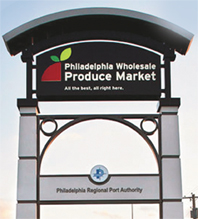Many merchants at the PWPM voiced concerns about the state’s heavy rains back in June. Yet Penn State University Extension horticulturalist Steven Bogash found the downpours flooded very few fields, and did not affect most vegetable or berry growers. By mid-June, growers using hoop houses and greenhouses were already harvesting strawberries and some vegetables. For Bogash, the season was ‘normal’ despite the soaking in June.
Demand
Local Still Hot
In Pennsylvania, 510,000 tons of fresh fruit and vegetables are produced each year, generating sales of more than $200 million.
Demand for local produce has remained relatively stable in the last year, with increases in certain commodities. Chris Powell, chairman of the Pennsylvania Vegetable Marketing and Research Program, reported increased interest in smaller watermelons and some “old school” crops such as kale, parsnips, and rutabagas as well as specialty varieties like colored beets (golden and white versus the traditional red) and rainbow carrots.
Curtis says many of his customers want locally grown lettuces and greens, and this can be problematic when excessive rain washes sand into the crops. In his opinion, when conditions are right, local and Canadian romaine can compare with the quality and consistency of produce out of California.
“A lot of our customers have a fixed requirement that the product has to be from California,” Curtis says. “Some retailers and wholesalers will readily use local and Canadian product from
good growers with all the proper GAP certificates and traceability in place. These shippers have a large following for their product.”
Levin also balances local with other domestic product as well as imports. Although “people are looking to support our farmers here in the states, and feel a sense of pride” in doing so, Levin still sources many fruits and vegetables from outside the United States. Surprisingly, he struggles to convince some customers certain items, such as bananas, are impossible to grow locally.
Jim Storey, who’s worked with his family at Quaker City Produce Company since the age of 12, says local berries, while in demand, don’t hold a candle to the California crop. Quaker City carries both local and California berries, but doesn’t often import from other countries. “When supply gets a little short, it helps us,” he says. “We’re able to sell to customers, knowing they might not be able to get it later.”
State branding programs and commodity cooperatives like Pennsylvania Simply Sweet Onions in Lancaster County, the Endless Mountain Tomato Cooperative in the western part of the state, and Knouse Foods, an apple co-op in Adams County, let brokers and wholesalers aggregate local supply. This in turn has led to an increase in fresh produce sold via direct sales to various merchants at the PWPM as well as wholesalers in New Jersey and New York. Brokers and wholesalers in search of local product can contact the Pennsylvania Department of Agriculture Bureau of Markets for help.



